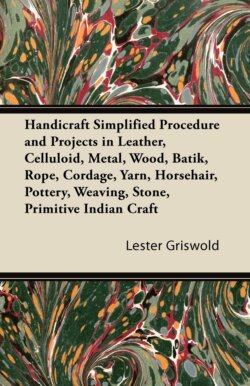Читать книгу Handicraft Simplified Procedure and Projects in Leather, Celluloid, Metal, Wood, Batik, Rope, Cordage, Yarn, Horsehair, Pottery, Weaving, Stone, Primitive Indian Craft - Lester Griswold - Страница 39
На сайте Литреса книга снята с продажи.
ASSEMBLY PROCEDURE Tooling Steer and Calfskin
ОглавлениеEdge Skiving. In articles where lining is used, it is desirable to reduce the thickness of the edge of both the lining and the outer leather. This gives a neater appearance to stitched and thong-laced edges, and renders a fold less bulky. The method of edge beveling or skiving is illustrated in Cut A. A skiving or leather paring knife is used as indicated. The leather is placed’ upon a smooth hard surface, skiving stone or plate glass, with the finished surface down. The point of the knife blade rests upon the stone, and this guides it as the cut is made across the edge of the leather. Thin layers of the flesh surface are removed successively until the desired thinness is secured. The edge on the knife must be kept very sharp by stropping frequently on the under surface of a piece of heavy leather.
AB
Note that the skiving starts near the top of the upper left edge and that the direction of the cut is outward in position A. The piece of leather is rotated until the edges are skived, leaving the corners at the beginning of each stroke. These are skived as shown in Cut B. In skiving an edge which is to be turned back on itself or over a gusset lining, it is desirable to score the leather where the fold is to be made, then remove, with the skiving operation shown in A the section of the surface between the score cut and the margin. Of course care must be taken to avoid cutting through.
Fig. 2
